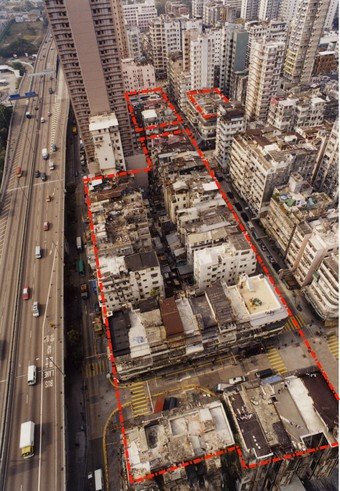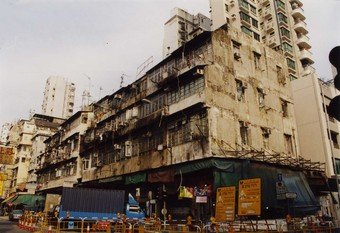

Redevelopment helps 680 families and boosts local jade market
The Urban Renewal Authority (URA) today (Friday) announced three development projects at a total cost of $2.53 billion that aim to improve the living conditions of about 680 families and create a "jade walk" to enrich the local character of Sham Shui Po simultaneously.
The projects are located in Hai Tan Street and Tung Chau Street covering three adjoining sites. The URA will submit planning application to the Town Planning Board to implement them as one single development scheme to achieve a comprehensive development. Covering a total area of about 80,000 square feet, this development scheme will be the largest of all the redevelopment projects in Sham Shui Po commenced by the URA or jointly with the Hong Kong Housing Society since 2002.
A team of about 130 URA officers conducted a freezing survey today to ascertain the actual number of households affected and occupancy status of the premises. The team paid special attention to vulnerable residents such as the elderly, disabled, new immigrants and single parents who may be in need of special help. A URA-appointed social service team provided by the Salvation Army was also present to offer assistance in these cases.
Mr. Joseph Lee, URA's District Development Director, said the projects involved a total of 37 dilapidated residential buildings built in the post-war period, some as early as 1949.
"There are 385 property interests and about 680 households. Judging by our experience in previous projects in Sham Shui Po, the owners and tenants would welcome the latest redevelopment scheme because most of the buildings are in such a poor condition that they are beyond economic repair. Redevelopment is virtually the only solution to help them improve their living condition substantially," Mr. Lee said.
The Hai Tan Street/Kweilin Street & Pei Ho Street projects will be implemented by way of a development scheme under section 25 of the Urban Renewal Authority Ordinance. The URA will soon submit a draft scheme plan to the Town Planning Board for approval.
"Upon approval by the Board and finally by the Chief Executive-in-Council, we shall issue acquisition offers to owners and, following acquisition, compensate or rehouse the tenants in accordance with the prevailing policy. The total compensation and rehousing cost is estimated at about $1.1 billion or 44 per cent of the total project cost," he added.
Upon completion, which is expected to be in 2013, the projects will deliver about 600,600 square feet of residential floor space and 120,000 square feet of retail commercial space.
The projects will also deliver two specially designed features for enjoyment by the local community. One is a "Jade Walk" in the segment of Pei Ho Street within the project site, next to an existing jade bazaar.
"The bazaar, housed in a temporary market building beneath the Tung Chau Street flyover, was opened about four months ago with the help of the Government and Sham Shui Po District Council. It has quickly become home to over 100 small vendors of Chinese jade and precious stones and has the potential of becoming a new local character," Mr. Eddie So, URA's Corporate Communications Director, said.
"To the URA, revitalisation is just as important as redevelopment. We have therefore proposed to design and build a small town square, with a theme on the art of jade at public appreciation level, right next to the jade bazaar. Hopefully this will provide the local community with an open space of special character and attract more people from outside Sham Shui Po to patronize the jade bazaar, thus enhancing the local economy."
The second special feature of the scheme is a "pebble walk" garden of 8,000 square feet for public use, especially the health-conscious who would appreciate the convenience of doing some morning or evening exercise in pebble trail walking without traveling the distance to the exercise trails in the countryside.
"Our initial thought is that it would be a petite garden landscaped with lots of greens and decorative stone columns replicating the columns on the façade of old, typical Sham Shui Po shops. Enclosing the greens on three sides would be a pebble walkway of about 660 feet long that gently spirals upwards to a view pavilion overlooking the project site," Mr. So said.
"Our community research survey in Sham Shui Po tells us that this feature might be especially popular with the adult residents who always appreciate a well-designed public open space for body exercise," he said.
"We need time to sit down and discuss together with the relevant government departments and the District Council. Both features are design concepts at this stage," said Mr. So.
Public consultation for the projects will follow shortly after completion of the freezing survey. The URA will hold briefing and consultation sessions to explain to the owners and tenants the planning approval procedure and, if approved, the acquisition and compensation arrangements next week.
Furthermore, a plan delineating the boundary of the projects plus a general description will be put on display for public inspection during the next two months in accordance with the Urban Renewal Authority Ordinance. The inspection points will be at the URA headquarters (10/F, Low Block, Grand Millennium Plaza, no. 181 Queen's Road Central, Sheung Wan), URA Neighbourhood Centre in Tai Kok Tsui (G/F, Bedford Tower, 68 Bedford Road) and the Public Enquiry Service Centre of the Sham Shui Po District Office (G/F, no. 303, Cheung Sha Wan Road). Members of the public may also call the URA hotline at 2588 2333 for enquiries and detailed information.
The new projects bring to 27 the number of redevelopment projects that the URA has commenced since the beginning of its redevelopment programme in March 2002. These include seven undertaken in association with the Hong Kong Housing Society. The total development cost of all the projects is estimated at about $23.4 billion.
(END)
